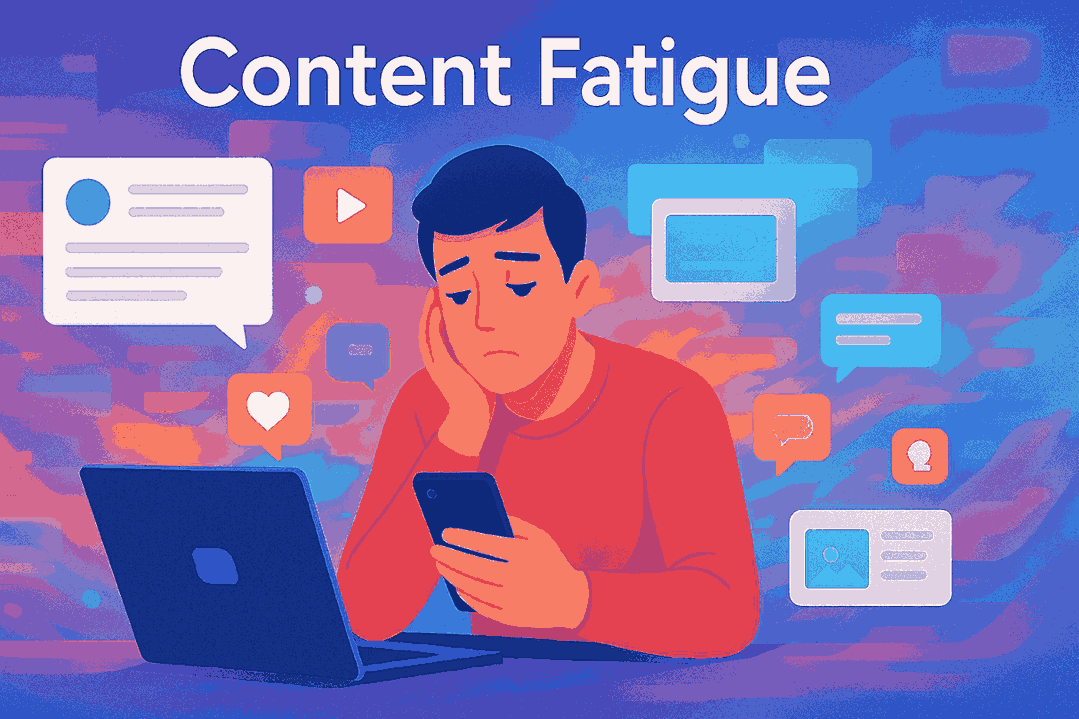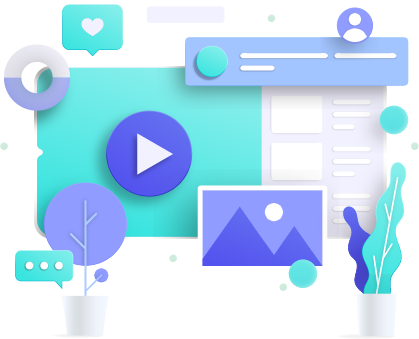If you’re publishing five posts a day and still seeing your engagement drop by 40% compared to last year, you’re likely facing content fatigue.
It’s true! Engagement rates across major platforms are dropping because of repetitive and low-value content.
In fact, Instagram’s engagement rate is down by 28% YoY (Social Insider).
But there’s a way out…
You can regain attention by creating fewer but higher-impact posts that feel fresh, emotional, and relevant.
In this guide, you’ll learn what content fatigue is, how to avoid it to drive meaningful engagements, and make your brand feel alive again.
What is Content Fatigue?
In Digital Marketing, content fatigue meaning encompasses a state of feeling overwhelmed or indifferent to online content, either because it provides no value or lacks originality. The key signs of content fatigue are a decrease in key engagement metrics. These include a reduced click-through rate, watch or read time, and fewer likes, comments, or shares compared to before.
These are not just numbers. These metrics mean that your audience is losing interest in your brand. As a result, it decreases your marketing ROI (return on investment). Also, content fatigue differs from content creation fatigue, which involves being overwhelmed by the pressure to produce more content consistently.
Why Does Content Fatigue Happen?
Think about it. Your target industry is full of brands vying to attract consumers and grow their business. The result? Your audience is constantly receiving the same information from multiple sources. If your content does not provide a unique value, they have no reason to stick around. This behavior has become even more noticeable recently. Here is why:

- Content Overload is real.
According to Exploding Topics, around 402.74 million terabytes of data are created every day. And a projected 181 zettabytes is generated in 2025 alone. The sheer volume of information bombarding people online is staggering.
- People are less attentive today.
Data from SQ Magazine indicates that the average human attention span has reduced to about 8.25 seconds. Moreover, according to Facebook, many mobile users spend only about 1.7 seconds deciding whether to engage with a piece of content.
- Engagement is dropping.
According to Rival IQ, engagement rates are dropping across all major platforms by double-digit percentages. Facebook is down 36%, Instagram 16%, TikTok 34%, and X 48%. This means that people are tuning out rather than interacting through clicks, likes, or shares.
- Time for consumption is not increasing. But content volume is.
A recent survey by Deloitte has found that people spend almost 6 hours per day on media and entertainment. And from 2024 to 2025, this hasn’t materially increased. However, more content and data are being created every day.
- Mental fatigue is here.
A 2024 meta-analysis on Information Overload found strong links between information overload, burnout, and reduced cognitive performance. As a result, this mental fatigue makes people more likely to skim past rather than engage deeply with content.
How to Avoid Content Fatigue: Key Strategies That Work
The answer is simple: don’t create more content. Create better content instead. Below you’ll find practical ways to achieve this by creating content that keeps your audience engaged.
1. Publish High-Value Content, But Less Frequently
Publishing high-value content means creating fewer pieces – but making each one worth your audience’s time. A case study by HubSpot found that posting up to 35 times per week brings only a negligible 5% increase in website traffic. This means that your audience can only consume so much in a given period of time.
Also, research by the Content Marketing Institute found that 83% of marketers differentiate themselves from competitors by creating better quality content. Meanwhile, only 30% achieve it by producing more. These numbers prove that volume alone no longer drives engagement. Quality does.
To create high-value content:
- Focus on your audience’s needs and search intent.
- Back up claims with credible stats, case studies, and quotes from experts.
- Provide in-depth value, not just surface-level, lengthy content.
- Keep your voice consistent with your brand’s values and tone.
- Cut unnecessary words tightly. Every sentence should serve a purpose.
2. Be Creative and Original
Another way to keep your audience engaged is by delivering information they haven’t seen or read before. You need to add a fresh perspective and a unique voice, instead of repeating what’s already out there. When people learn something new from your content, they will keep coming back for more. This can help you beat content consumption fatigue.
To stay creative and original:
- Instead of copying trends, reinterpret them from your own experience.
- Use data, insights, and stories to create a stronger impact.
- Check existing content and ensure yours adds fresh value.
- Share genuine experiences and lessons instead of polished marketing talk.
- Partner with creators, customers, or experts to bring in diverse viewpoints.
3. Create Interactive and Diverse Content
Interactive and diverse content goes beyond passive reading or watching. It invites your audience to participate. This can be through polls, quizzes, interactive videos, or user-generated content. This strategy engages people and makes them feel involved in your brand.
According to a study by Demand Metric, interactive content generates 2 times more conversions than passive content. Another factor that can help is connecting with your customers through diverse content formats. These include videos, blogs, infographics, podcasts, and more.
To create more interactive and diverse content:
- Add polls and quizzes.
- Create interactive videos.
- Offer challenges or competitions with rewards.
- Ask followers to share their stories and opinions.
- Align content recommendations to user behavior or preferences
4. Give Your Audience Memories, Not Materials
Today, consumers want meaningful experiences from brands, not just content. In fact, data from GWI suggests that 58% of Americans prefer spending money on experiences, which is 14% more than the global average.
One way to make your brand experience memorable and reduce consumer fatigue is to use emotional storytelling in your campaigns. In fact, research by Fast Company found that advertising campaigns with purely emotional content perform 2x as well as those with only rational content. When your message makes people feel emotions like joy, curiosity, or even empathy, they’re more likely to remember your brand and share it.
How to use emotional storytelling effectively:
- Start with purpose. Know the “why” behind your message.
- Show real people. Use relatable characters or customer experiences.
- Show how problems are felt, not just how they’re solved.
- Use visuals to portray the emotion. Choose imagery, colors, and words that fit the mood.
- Keep it authentic. Avoid exaggerated claims. Genuine stories build trust.
- End with meaning that inspires or motivates your audience.
5. Distribute Content Across Multiple Channels
Data from Statista shows that as of October 2025, 73.2 % (6.04 billion people) of the world population uses the internet. Of this, 68.7% use social media. Moreover, every social media user engages with an average of 6.83 different social media platforms, according to Backlinko.
What does this indicate? If you’re only posting on one platform, you miss out on countless other ways to engage your audience. It’s not about posting the same thing everywhere. It’s about adapting your content to fit each channel’s format and audience behavior.
How to do it effectively?
- Identify where your audience spends the most time.
- Tailor content format to their preferred channels
- Repurpose lengthy content into multiple short formats like a carousel, infographic, video clip, or email.
- Plan and automate posts to stay consistent without overloading followers.
- Monitor engagement by platform and focus on what drives the most interaction.
6. Make Your Content Feel Personal
One major cause of content consumption fatigue is irrelevant and generic content. The solution? Content personalization. It is a powerful strategy to make your audience feel heard and valued. And no, it’s not just about using their name in newsletters or messages. You need to understand their problems, how they prefer to solve them, and the right time to deliver the right message.
How does this help fight content fatigue? Data from Blogging Wizard shows that 76% of consumers get tired of businesses that do not offer personalized experiences. Moreover, Optimove’s Consumer Marketing Report shows that 81% of consumers are more likely to open an email tailored to their interests than one that simply uses their name.
Practical tips to personalize your content:
- Group users by interests, behavior, or stage in the buyer journey.
- Analyze engagement metrics to understand what topics or formats work best.
- Create solutions that address your audience’s specific pain points.
- Match your language and style to your audience’s preferences.
- Use AI for content recommendations, personalized emails, or predictive insights.
- Reply to questions and provide feedback to strengthen the connection.
7. Refresh Old and Decaying Content
Content decay means a gradual decrease in a piece of content’s organic performance and visibility in search results. What does it mean for content marketing fatigue? No matter how much value you pack into your content. Over time, the information becomes outdated, as new trends emerge and facts change.
The result is a large piece of irrelevant content that fails to deliver any real value to the reader. Refreshing it with updated content keeps your best-performing pieces relevant and timely for your audience.
To refresh content effectively:
- Audit your content library: Identify outdated and low-performing pieces.
- Update information: Refresh statistics, links, and examples with the latest data.
- Boost SEO: Add relevant keywords, meta descriptions, and internal links.
- Enhance visuals: Use new images, charts, or infographics to improve clarity.
- Repurpose content: Convert posts into videos, infographics, or social media
- Align with user intent: Address the current audience’s needs and search behavior.
- Re-promote it: Share content across all channels to increase reach and visibility.
8. Get Feedback from Your Audience
Metrics may tell you about the lack of engagement with your content. But listening to your audience helps you understand the reasons behind the consumer fatigue. By getting feedback, you get a clear understanding of what they like, what they skip, and what they want more of.
It also helps build trust and keep your audience engaged. In fact, data from Forbes suggests that 77% of people view brands more favorably if they gather and apply customer feedback.
How to gather and use feedback effectively?
- Run quick polls or surveys on social media or via email marketing.
- Ask what topics or formats they prefer.
- Encourage honest responses through open questions.
- Listen to what people say about your brand or niche on online forums or social sites.
- Create feedback loops to keep your content fresh and relevant.
Other Types of Content-Related Fatigue You Should Know
Content fatigue can take many forms besides just consuming content. It can affect both audiences and creators. Here are some other types to spot early and tailor your strategies to stay engaging.
- Content Creator Fatigue: Exhaustion from producing content non-stop. It includes algorithm pressure and a lack of creative breaks.
- Marketing Fatigue: Also called brand fatigue, it happens when consumers tune out repetitive or irrelevant ads, emails, and brand promotions.
- AI Content Fatigue: Overuse of AI-generated content that is generic and emotionless. It feels less personal and leads to lower engagement.
- Social Media Content Fatigue: Your followers are seeing too many posts from different brands with the same message – multiple times a day.
Final Words
Content fatigue is costing brands not only traffic but also meaningful engagement. To overcome it, focus on creating high-value and audience-centric content. Build connection through immersive experiences and memorable content. Refresh old content and align your content strategy around your audience’s pain points.
At PNC Logos, we help businesses like yours with research-backed digital marketing strategies. We know that you want to increase your online presence and keep customers coming back. So, we do the heavy lifting to get you there. Contact us today to fight content fatigue and grow your business.





